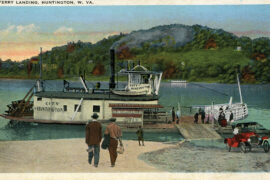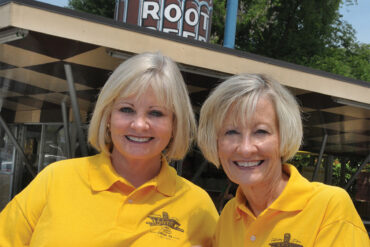By Charles and Pamela Bowen
HQ 51 | SPRING 2004
Spring has a definite color in Huntington. Wave upon wave of white and pink dogwoods burst into bloom throughout town. Simple, elegant blossoms of this fragile tree seem to glow with their own energy, whether caught shimmering in the morning sun or seen in the warm light of streetlamps after dark.
Are dogwoods – a springtime fixture for as long as most of us can remember – just naturally so prevalent in our region or did specific people play a part in this local success story?

A dogwood on every lawn was the goal of the Huntington Council of Garden Clubs in the early 1950s. Drive around the city in the spring and you’ll see the results of the group’s five-year plan to turn Huntington into “The Dogwood City.” Dogwoods can be found on every block, if not in every yard. They’re stunning in all seasons, with dense green foliage in summer, red berries and scarlet leaves in fall, delicate bare branches in winter and, of course, a spectacular bounty of blooms in spring.
“Most yards don’t have room for big trees. Dogwoods compliment, not cover up, the homes in this area,” explains John Marra, West Virginia University Extension agent for Cabell County. Pink ones are particularly attractive against red brick houses, and the trees don’t outgrow the space.
An earlier beautification project began in the early 1930s, when the Huntington Garden Club planted large dogwoods along Four Pole Creek in Ritter Park and sold carloads of small dogwoods at cost. “Many of the dogwoods in town were planted in those early campaigns,” according to Margie Hollandsworth of the Huntington Garden Club, who has kept the original club reports and newspaper articles about the campaign.
Following the success of this early effort, the Huntington Council of Garden Clubs undertook a five-year project to stimulate citywide interest in the planting of dogwoods in 1949. At that time, the West Virginia Garden Club was urging clubs throughout the state to encourage the planting of the native dogwood. Within five years, all the local garden clubs had planted more than 6,000 dogwoods in parks and cemeteries, in other public areas and along U.S. 60 in Westmoreland, and encouraged many homeowners to plant dogwoods in their own yards.
Huntington natives have fond memories of the dogwoods. For example, Steve Roberts, president of the West Virginia Chamber of Commerce, enjoyed climbing the low trees when he was very young, and remembers the annual Easter photograph with his sister in front of a beautiful dogwood in his parents’ front yard. Roberts also proudly helped his grandfather plant a white and pink dogwood together, so the colors would intermix.
The beauty of these blossoms is particularly striking to those who didn’t grow up here. “We moved here in 1968 and that first spring, we were awed by the beautiful dogwoods,” said Ruth Sullivan, founder and director of the Autism Services Center. When she ran out of room in her own yard, she started donating dogwoods to Ritter Park. “I planted trees for my children and grandchildren. I planted one for my husband when he died. My daughter planted one for me. We have a Sullivan Grove in the park.”
As part of his job, Roberts travels all over the state and he always meets people with Huntington stories. “I can’t tell you how many people come up to me after a speech and say they have fond memories of Huntington because they honeymooned there in the 1940s and 50s.” The two things people always mention, Roberts said, are Huntington’s wide streets and beautiful dogwoods.
Long after the original infusion of dogwood plantings, the tradition continues. Garden clubs and other organizations today plant and sell dogwoods every spring. When former Cabell County Sheriff Joseph G. Neal died in 1996, the Branches domestic violence shelter was selling dogwoods as a fund-raiser. Many of Neal’s friends bought the trees and donated them to Ritter Park in memory of Neal.
“My father loved walking through the park and that made it so much more special,” said Neal’s daughter, Mary Witten Wiseman. She said one of those donated trees stands near the log cabin in the park and “I always smile when I see it because it was in memory of my father.”

Many individuals have also provided trees to the park system over the years. Donations of trees to the parks are always welcome, said Rick Abel, deputy director of the Greater Huntington Park and Recreation District, which manages about 900 acres in dozens of parks in Cabell and Wayne counties as well as four cemeteries. Abel said about 10 percent of the trees in Ritter Park are dogwoods.
One person perhaps most associated with dogwoods in Huntington is Evelyn Richards. She worked on the park board’s “re-greening” project in the mid-1970s when more than 4,000 trees were planted throughout the county. During her campaigns for Cabell County Commission and the West Virginia House of Delegates, she opted for dogwoods instead of yard signs. Supporters could request a tree for their yard, and she would buy it and have it planted and adorned with a red, white and blue bow.
Richards said she never planted less than 25 dogwoods per campaign and she was elected six times. “I feel that was something I could give Huntington and leave with them forever.”
Many Christians consider the dogwood as a visual reminder of their faith. According to legend, the dogwood was as large and strong as an oak 2,000 years ago, and its hard wood was used for Jesus’ cross. The dogwood was distressed at being put to this cruel use, so Jesus took pity and deemed that forever after, the tree would be too small and twisted to be used that way. That’s why the dogwood’s blossoms are in the form of a cross, with nail prints stained with rust at the end of the bracts and a crown of thorns at the center of each bloom.
But our beautiful dogwoods may be doomed, prey to a disease called dogwood anthracnose, which is wiping out most of the wild dogwoods in the forests.
Marra, who can be seen several times a week giving gardening advice on WSAZ-TV, described the symptoms: Leaves become light green and start to droop and fold. Purple spots with brown centers will appear in the leaves, and abnormal water spouts will grow from the base and trunk of the tree. If these symptoms appear, the tree can be saved by using a fungicide called Daconil 2787. “Spray the tree once when you start seeing the bracts in the spring, wait seven days and spray again, then wait seven days and spray again,” Marra advised.

But the main reason we’re losing dogwoods around our homes is a condition Marra calls “mow-itis” – hitting the tree’s bark with a lawn mower or string trimmer. This injures the trunk, which opens the way for insects and disease. Because the native dogwood (cornus florida) is susceptible to disease, many people planting new trees are choosing cornus kousa, which is a similar size to our native dogwoods but resistant to anthracnose. These trees bloom later in the season, after the leaves appear.
However, many people still prefer the original, according to Mark Springer of Lavalette Nursery, which provided many of the dogwoods for the early planting campaigns. “There are some new dogwoods that are a cross between kousa and florida. They look similar to the old dogwoods but are more resistant.”
Springer agrees with Marra that the main threat to dogwoods is damage to the trunk from mowers and trimmers. He advises to keep mulch around the tree so grass cutters won’t have to get too close.
Planting dogwoods is still “the thing to do” in Huntington. “When my wife and I bought our first house on 10th Avenue, the very first thing we did was buy azalea bushes and a dogwood tree,” Roberts recalled.
“We both felt you weren’t really keeping house until you had a dogwood tree.”
To Donate A Tree
The Greater Huntington Park and Recreation District is happy to accept donations of trees for its parks, but would prefer to be involved in the process of tree selection. For more information, call Rick Abel, deputy director, at 696-5954.
How the Dogwood Got Its Name
No one knows exactly how the dogwood got its name. But according to the book “100 Flowers and How They Got Their Names” by Diana Wells, it was given the Latin name cornus (meaning horn) because its wood was as hard as horn. Cornus sanguinea, the English dogwood, was called the “doggeberry tree” because its berries were not fit to be eaten, or given to dogs. A Victorian garden writer said it got its name because its leaves were brewed into a concoction to wash fleas off dogs or to wash “mangy dogs.” Throughout history, dogwood leaves, berries and bark have been used to intoxicate fish, make gunpowder, soap, dye, ink, primitive toothbrushes and to relieve fever.





